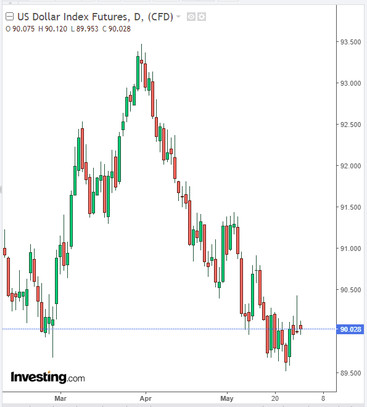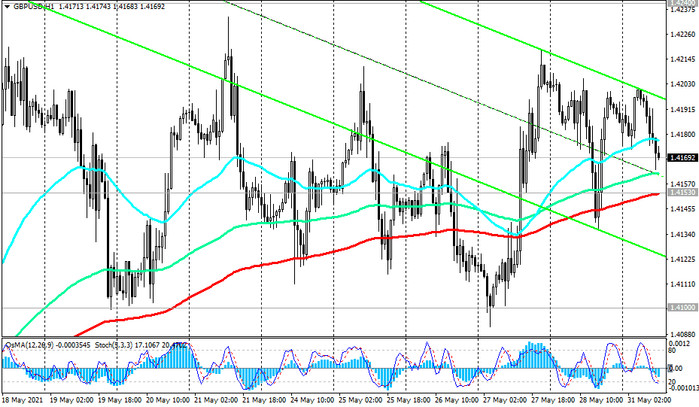The yield on 10-year US government bonds declines at the start of the new week. It is also followed by the DXY dollar index. As of this writing, DXY futures are traded near 90.03, 4 pips below today's opening price. At the same time, the 90.03 mark corresponds to the closing levels of the last week, which the DXY dollar index spent in the range.

At the same time, the current dollar decline looks so far unconvincing. Trading volumes in the financial market today are expected to be insignificant due to the fact that the US has a day off to celebrate Memorial Day. Banks and stock exchanges do not work in the country on this day.
At the same time, in the UK today is a bank day off, which also significantly reduces the number of participants and the volume of trading in the financial market.
Whether it is related to this or not, the pound is declining, including against the dollar, in the first half of today's trading day. As of this writing, the GBP / USD pair is traded near 1.4170 mark, 10 pips below today's opening price. However, betting on a further deeper decline in GBP / USD is unlikely to be appropriate in the face of a weakening dollar.
Probably, the decline in GBP / USD to the support levels zone 1.4153, 1.4100 will be a good opportunity to build up long positions.

Last week, there was another positive data on the US. The PMI index of Chicago in May rose from 72.1 to 75.2 points, which turned out to be better than market expectations (falling to 68). According to other data released on Friday, the price index for personal consumption expenditure (PCE) in the United States in April rose 0.6% from the previous month and 3.6% from the same period last year. The Fed uses the PCE index to track inflation. Nevertheless, the Fed leaders prefer to ignore the rise in inflation for the time being.
Higher inflation rates have a negative impact on the national currency if the central bank does not tighten monetary policy in response to accelerated price increases.
Given the fact that the Fed is unlikely to make any changes to monetary policy, inflation above the target level in the short term will put pressure on the dollar.
In addition, the markets are discussing the US national budget for 2022, presented by Joe Biden last Friday, which will require an increase in federal budget spending in 2022 to $ 6 trillion, and which could also negatively affect dollar quotes, accelerating inflation in the country.
If we look at the short-term prospects of the dollar within the current week, it is possible that the dollar will hold it in the range before the publication of key US macro data on Friday. At 12:30 GMT, monthly data from the US labor market will be published, which (along with data on inflation and GDP) are of key importance for the Fed in determining the prospects for its monetary policy.
Earlier, Fed officials said that compared to accelerating inflation, the state of the labor market is of greatest concern.
“In my opinion, judging by the April labor market report, we have not made further significant progress”, said Fed Deputy Chairman Richard Clarida earlier this month. “We are seeing a very volatile period”, he added. Many economists also believe that, despite strong inflation in the US, some important macro data, in particular the labor market, remain weak and, in their opinion, it will take several more strong months before the Fed starts discussing the issue of tightening policy.
One way or another, today, due to the holidays in the UK and the USA, the financial markets are calm. But it can be deceiving, like before the storm. And this storm may be the publication of data from the US labor market on Friday. Strong indicators are expected. If the real data exceed the forecasts of economists (growth of average hourly wages by +0.2%, growth in the number of new jobs created outside the agricultural sector by +621,000, decrease in the unemployment rate to 5.9% from 6.1%), then the prospects for a soon withdrawal of the Fed's stimulus policy will strengthen, which means that more forward-thinking investors will gradually begin to reduce short positions in the dollar, which, in turn, will cause, if not growth, then its stabilization at current levels before a further period of strengthening. But this is a more distant prospect. As long as the Fed leaders prefer to take a wait and see attitude, the dollar will remain under pressure.





